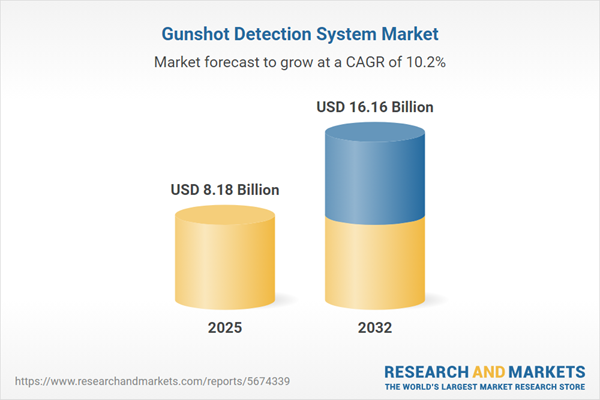Speak directly to the analyst to clarify any post sales queries you may have.
The gunshot detection system market is gaining momentum as organizations across public safety, defense, and commercial sectors seek more robust solutions for real-time threat identification and rapid emergency response. Technology innovation, greater cross-sector collaboration, and evolving security needs are driving strategic deployment across global markets.
Market Snapshot: Gunshot Detection System Market
The Gunshot Detection System Market grew from USD 7.44 billion in 2024 to USD 8.18 billion in 2025. It is expected to continue growing at a CAGR of 10.17%, reaching USD 16.16 billion by 2032. Robust demand stems from the urgent need for rapid incident response and improved situational awareness in critical environments including urban centers, infrastructure, and transportation. As technology advances and adoption increases, the market landscape is maturing into a diverse ecosystem with multiple high-value applications.
Scope & Segmentation
This research covers detailed segmentations and regional analyses, equipping senior decision-makers with actionable intelligence on the gunshot detection ecosystem.
- Component: Hardware (output, processor, sensor), Services (installation, maintenance), Software (analytics, detection algorithm, user interface)
- Application: Commercial (hospitality, retail), Defense (border security, counter terrorism), Public Safety (indoor, outdoor), Transportation (airports, railways)
- End User: Government, Law Enforcement, Military, Private Security
- Sensing Technology: Acoustic, Infrared, Multi Sensor (acoustic + infrared, acoustic + microwave)
- System Type: Integrated, Standalone
- Regional Coverage: Americas (North America, Latin America), Europe, Middle East & Africa, Asia-Pacific
- Key Companies: SoundThinking, Raytheon Technologies, Lockheed Martin, Thales Group, HENSOLDT AG, Leonardo, QinetiQ Group, Elta Systems, BAE Systems
Key Takeaways for Decision-Makers
- Advanced gunshot detection platforms are central to incident response strategies in high-density environments and critical infrastructure, as communities confront rising security challenges.
- The integration of acoustic, infrared, and hybrid sensor technologies has shifted detection from pilot projects to large-scale, mainstream implementations, enhancing cross-jurisdictional response coordination and resource deployment.
- Ongoing advancements in machine learning, edge computing, and real-time analytics drive detection accuracy and operational efficiency, while streamlining integration with broader security networks.
- Strategic partnerships, collaborative research agreements, and adaptive design—such as modular architecture—enable market players to meet evolving regulatory, operational, and stakeholder requirements.
- Segment-specific solutions are emerging, with commercial venues favoring discreet installations, defense agencies emphasizing rugged, mission-ready systems, and public safety requiring flexible, high-throughput deployments tailored to both indoor and outdoor settings.
- Varying regional priorities regarding data privacy, interoperability, and investment models reinforce the need for tailored deployment and strategic alignment with local policies and infrastructure maturity.
Tariff Impact on Supply Chains and Strategy
Recent U.S. tariff evolutions on imported hardware components have increased production costs and prompted a realignment of supply chains and sourcing strategies for gunshot detection solutions. In response, manufacturers are investing in domestic assembly, negotiating with regional suppliers, and refining system architectures to reduce dependency on high-tariff imports. These measures not only address immediate cost pressures but also influence product development timelines and partnership strategies.
Methodology & Data Sources
This analysis applies a robust multimethod approach, combining in-depth primary interviews with market participants, thorough secondary research from industry publications and regulatory sources, and rigorous data triangulation. Quality assurance protocols and peer review processes underpin all findings to ensure credibility and consistency.
Why This Report Matters to Senior Leaders
- Informs strategic planning by clarifying which technology, application, and regional segments offer the highest near- and long-term value.
- Guides operational resilience and cost optimization in the context of evolving regulatory and tariff landscapes.
- Benchmarks competitor innovation, partnership models, and best practices to enhance stakeholder positioning and investment confidence.
Conclusion
Senior decision-makers can leverage this research to navigate the complexities of the gunshot detection system market with greater confidence. Aligning business strategies with technology innovation and local market realities will accelerate security outcomes and support sustainable growth initiatives.
Additional Product Information:
- Purchase of this report includes 1 year online access with quarterly updates.
- This report can be updated on request. Please contact our Customer Experience team using the Ask a Question widget on our website.
Table of Contents
3. Executive Summary
4. Market Overview
7. Cumulative Impact of Artificial Intelligence 2025
Companies Mentioned
The companies profiled in this Gunshot Detection System market report include:- SoundThinking, Inc.
- Raytheon Technologies Corporation
- Lockheed Martin Corporation
- Thales Group
- HENSOLDT AG
- Leonardo S.p.A.
- QinetiQ Group plc
- Elta Systems Ltd.
- SoundThinking, Inc.
- BAE Systems plc
Table Information
| Report Attribute | Details |
|---|---|
| No. of Pages | 195 |
| Published | October 2025 |
| Forecast Period | 2025 - 2032 |
| Estimated Market Value ( USD | $ 8.18 Billion |
| Forecasted Market Value ( USD | $ 16.16 Billion |
| Compound Annual Growth Rate | 10.1% |
| Regions Covered | Global |
| No. of Companies Mentioned | 11 |









